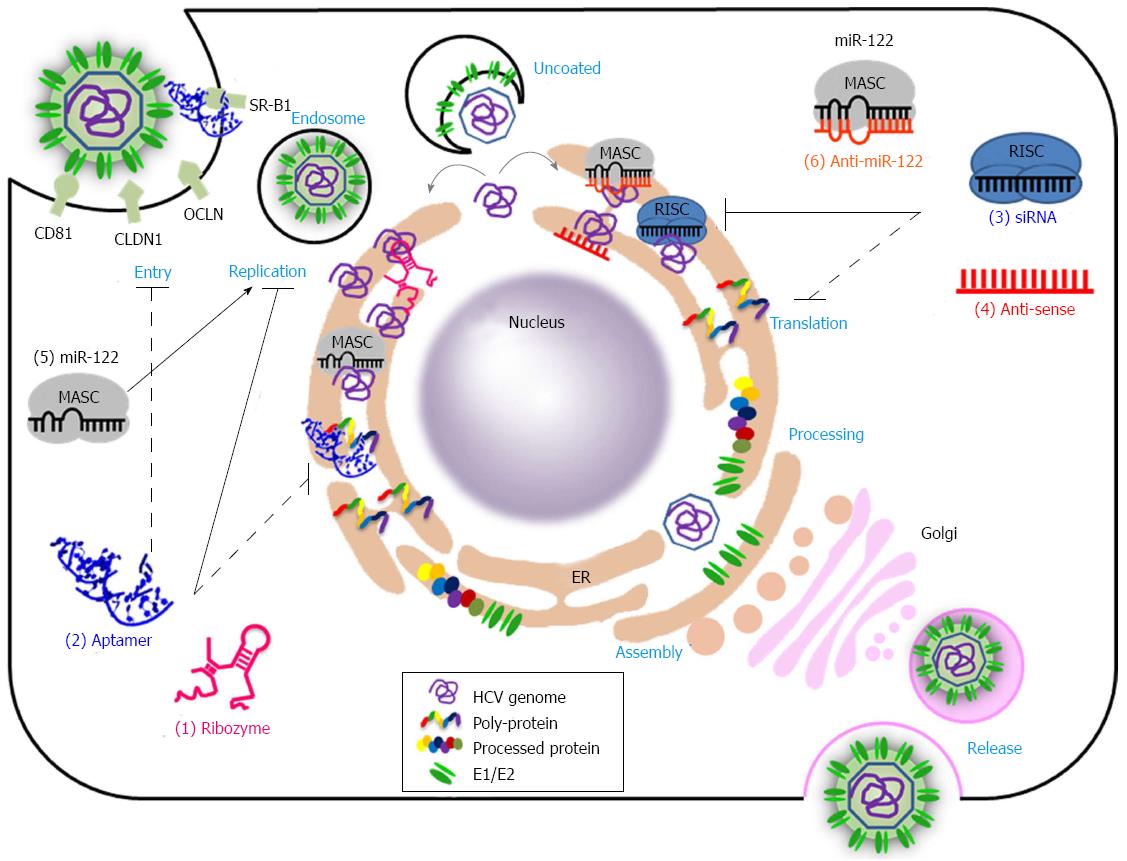Copyright
©2013 Baishideng Publishing Group Co.
World J Gastroenterol. Dec 21, 2013; 19(47): 8949-8962
Published online Dec 21, 2013. doi: 10.3748/wjg.v19.i47.8949
Published online Dec 21, 2013. doi: 10.3748/wjg.v19.i47.8949
Figure 1 Overview of hepatitis C virus life cycle and antiviral target.
The hepatitis C virus (HCV) life cycle includes entry, un-coating, replication, translation, processing of poly-proteins, assembly, and release. HCV has an RNA genome which replicates and is translated in the cytoplasm. Various nucleic acid-based therapeutics target viral or host factors during the HCV infection as follows: (1) Ribozymes cleave or reprogram HCV RNA, sequence-specifically, thus inhibiting HCV RNA expression or inducing new therapeutic gene expression; (2) Aptamers can target to receptors (CD81, CLDN1, OCNL, SR-B1), which are needed for HCV entry, or to HCV regulatory proteins. Therefore, aptamers function as decoys during HCV entry or during replication to inhibit the viral life cycle; (3) siRNAs target the HCV genome as well as host factors, and can cleave and/or suppress translation of target RNA, sequence-specifically, through the RNAi induced silencing complex (RISC); (4) Antisense oligonucleotides induce inhibition of HCV gene expression through RNase H-dependent degradation of hybridized HCV RNA or by blocking access to cellular machinery necessary for the HCV translation; (5) MiR-122 is a host factor which regulates HCV replication. MiR-122 is incorporated into microRNA associated stabilizing complex (MASC) and increases HCV replication through binding to the HCV 5’ IRES; and (6) Anti-miR-122 down-regulates miR-122, inhibiting HCV replication. Lines represent the following: inhibition of replication (solid line), translation (short dashed line) and entry (long dashed line). An arrow indicates augmentation (black arrow) or the direction (gray arrow) of replication. Nucleic acid-based therapeutic molecules are shown as follows: ribozyme (pink), aptamer (blue), siRNA (sky blue), anti-sense (red) and anti-miR-122 (orange). CD81: Cluster of differentiation 81; CLDN1: Claudin-1; OCLN: Occludin; SR-BI: Scavenger receptor BI; ER: Endoplasmic reticulum.
- Citation: Lee CH, Kim JH, Lee SW. Prospects for nucleic acid-based therapeutics against hepatitis C virus. World J Gastroenterol 2013; 19(47): 8949-8962
- URL: https://www.wjgnet.com/1007-9327/full/v19/i47/8949.htm
- DOI: https://dx.doi.org/10.3748/wjg.v19.i47.8949









